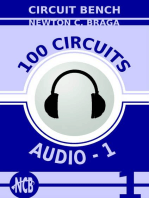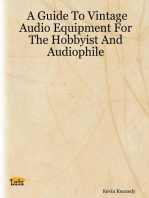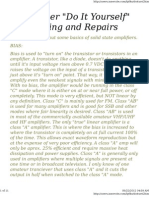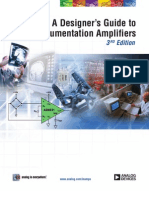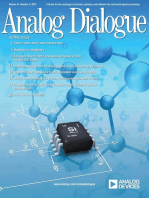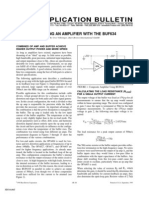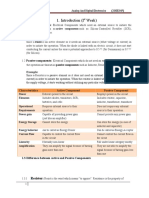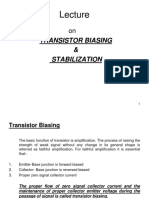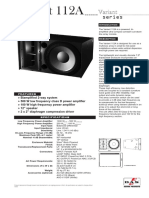SMPS For Audio
SMPS For Audio
Uploaded by
Tudor Gabriel GavrilescuCopyright:
Available Formats
SMPS For Audio
SMPS For Audio
Uploaded by
Tudor Gabriel GavrilescuOriginal Title
Copyright
Available Formats
Share this document
Did you find this document useful?
Is this content inappropriate?
Copyright:
Available Formats
SMPS For Audio
SMPS For Audio
Uploaded by
Tudor Gabriel GavrilescuCopyright:
Available Formats
Copyright 2005
Switching Power Magazine
ne of the last bastions of analog technology is in audio reproduction. Electronics hobby-
ists have delighted in building their own audio equipment for decades, and it is still an area that is accessible to an engineer with basic power skills, and some basic lab equipment. Most other areas of electronics have been handed over to the microprocessor, and digital technology, which is far more difficult to engineer for the hobbyist.
Most avid power supply designers have been tempted at some time in their career to throw together an audio amplifier, and in doing so, realize very quickly that most of the amplifier consists of power supplies, thermal management, and power management. The demands on the power system are quite unique in audio, and solid design experience is needed to make the system work well. The domination of the power processing part of an amplifier makes it an ideal target for more modern power conversion, but for many reasons, it has been slow to react.
Copyright 2005
Switching Power Magazine
SMPS for Audio
Figure 1 shows the allanalog audio system. As we'll see in this article, the power amplifiers are not very different from power supply designs. Figure 2 shows where the large audio manufacturers want to take the future of audio sys- Fig. 1: All-analog system - still the choice for some high-end consumers, but a very small piece of the total audio marketplace today. For most consumers, the front end has been replace with digital. Despite this tems, at all levels of power and applications. switching, power supplies and switching amplifiers have been slow to penetrate this marketplace. This is now changing at an accelerating pace, with varying levels of success. In between these two extremes are numerous opportunities for high-frequency power conversion. Despite the fact that digital audio has been around for 25 years, we are only just beginning to see all-digital audio systems with embedded switched-mode power and amplifiers and is not at all clear that this technology will be embraced by the consumers as the hands-down winner. Meanwhile, switching power supplies are finally making significant inroads into audio products. In this article, I will talk about the opportunities and potential problems that arise in using switchers in audio systems. speaker loads are purely resistive, and the nominal rating typically refers to the minimum value of impedance in the region where the speaker is resistive. And nominal really means just that a 4 ohm speaker can be 2.4 ohms when measured. Further complicating the situation is the crossover network, which can also present a substantial load to an amplifier. Some amplifier manufacturers work closely with speaker makers to optimize the rail voltage for the specific load. This has become more popular in many different market segments recently, but it is still the exception to the rule. A simplified way to consider the output of a linear audio amplifier is as a linear regulator, where the reference is the audio signal. It is impossible to specify an optimum value of the rail voltage for such a regulator. Low impedance loads require more current and less voltage, and much of the rail voltage results in dissipation in the power devices. The amplifier can run much more efficiently with a higher impedance load that runs the output voltage closer to the rails. Widely-varying load requirements can be much better dealt with from a dissipation and thermal design point of view with a switching amplifier, one of the major reasons that the industry is pushing in this direction.
Power Dissipation Issues
Calculating the actual power supply requirements for a power amplifier is not easy. One reason is that amplifiers must drive a wide range of loads. A typical audio amplifier is specified to work into 2, 4, or 8 ohms. Older systems can be specified for 16 and 32 ohms, reflecting speaker technologies of the day. Even calculating typical power dissipation can be extraordinarily difficult for an amplifier. Very few
Fig. 2: All digital system with fully integrated switchers and amplifiers. (The last step of the chain remains analog, of course.) Large initial investments will produce silicon-intensive solutions which close off the market to many smaller players, but allow high profits with mass production. Noise issues from the switching supplies and switching amplifiers will always provide issues with digital timing, and reconstruction of the analog waveform at the output. Tremendous sophistication in digital algorithms are needed to preserve acceptable sound quality.
Copyright 2005
Switching Power Magazine
SMPS for Audio
Audio Market Segments
In the audio industry, many market segments are involved in audio power amplifiers. Here is a quick overview of the different areas:
the others, and this market continues to mystify major audio companies that often find themselves compared unfavorably with companies that are little more than garage operations.
Consumer Audio
Consumer audio includes home stereos, PC speakers, and surround-sound systems for home theater. The name of the game in this area is severe cost reduction, with switched-mode amplifiers finding their way in the form of integrated modules in very low cost systems. For less than $100, you can buy a 5.1 channel system, with DVD and CD player, including biamped speakers, all operating at reasonable power levels. (We won't talk about the quality of the sound let's just say you get what you pay for.) In these low-cost systems, there is little room for creative engineering. Snazzy electronic features seem to drive sales, rather than sound quality. Switchmode power and amplification is essential here, since the cost of linear regulators cannot be absorbed, and the mass production levels demand high silicon integration with minimum passive parts. Integrated Class D amplifier modules are now commodity components for such systems.
Musical Instrument/DJ
For musicians, the amplifier is a subsystem built into the overall product, such as in a guitar amplifier with speaker, or powered keyboard. This category also includes amplifiers for smaller speakers as used by mobile DJs and home recording studios. The emphasis is on cost. While better sound is very desirable, most musicians cannot afford the amplifiers that they would like to buy, and the marketplace is very price competitive.
Automotive Sound
Automobile manufacturers drive the cost of automotive sound along with high packaging density. People listen to audio without video more in their car than anywhere else, and this is a very large marketplace. That doesn't mean the sound has to be the best, since the car presents special considerations. Ambient noise is high in a car, which means dynamic range is typically small. One of the major reasons that most modern music (and most radio stations) compress their audio signal to a 10 dB dynamic range is for car listening. There is also a subset of car audio that demands SPL and nothing much else, and there are even contests around the country for maximum SPL at levels which would shatter normal car windshields. Most of the time, (we hope) these are remote controlled without anyone in the car. Efficiency is sorely needed, and switchers have penetrated deep into this market.
Professional Sound Reinforcement
This category includes standalone rack-mount amplifiers used for concerts, theaters, churches and nightclubs. It also includes powered speakers for the same venues, in which the power supply and amplifier are integral to the loudspeaker. The highest power products are found here. The emphasis is on reliability, since downtime of the system is an unacceptable cost. You might initially think that sound quality is the number one concern for sound reinforcement professionals, but subjective sonic differences between different manufacturers and different models are outweighed by the primary concerns of reliability, size, weight, and cost.
Audio Power Amplifier Technologies
Opportunities for applications of switched-mode power depend heavily on the type of amplifier that is being designed. In the simplest case, the power supply can be completely separate, just providing voltage rails for the amplifier to use. At the next level, the power supply can be adjusted to follow the demands of the input signal. And at the most complex and involved level, the switchedmode power supply becomes the amplifier itself. In this article, we are limiting our discussion to the most widely used topologies; there are many variations on the basic topologies but a comprehensive treatment is beyond the scope of this article. Class A, Class B, Class G/H, and Class D topologies comprise most of the audio power industry.
Audiophile Sound
There is a small, but significant marketplace that craves a sound reproduction quality that mimics a live music event. Emphasis is on audio performance, with little or no concern for cost. Systems can cost upwards of $100k. CD players alone can cost $40k, and speakers up to $75k. Standalone power amplifiers are used for high-end home audio, and home theater. A complete range of amplifier designs and technology can be found competing with each other here, from horrendously inefficient tube designs which operate at less than 10% efficiency, to 90+% efficiency class D amplifiers from respectable audio companies such as Bang and Olufsen. Surprisingly, no one technology has won out over all
Copyright 2005
Switching Power Magazine
Power Supply
Design Workshop
Gain a lifetime of design experience . . . in four days.
Workshop Agenda
Day 1
Morning Theory
Converter Topologies Inductor Design Transformer Design Leakage Inductance Design with Power 4-5-6
Day 2
Morning Theory
Small Signal Analysis of Power Stages CCM and DCM Operation Converter Characteristics Voltage-Mode Control Closed-Loop Design with Power 4-5-6
Day 3
Morning Theory
Current-Mode Control Circuit Implementation Modeling of Current Mode Problems with Current Mode Closed-Loop Design for Current Mode w/Power 4-5-6
Day 4
Morning Theory
Multiple Output Converters Magnetics Proximity Loss Magnetics Winding Layout Second Stage Filter Design
Afternoon Lab
Design and Build Flyback Transformer Design and Build Forward Transformer Design and Build Forward Inductor Magnetics Characterization Snubber Design Flyback and Forward Circuit Testing
Afternoon Lab Afternoon Lab
Measuring Power Stage Transfer Functions Compensation Design Loop Gain Measurement Closed Loop Performance
Afternoon Lab
Closing the Current Loop New Power Stage Transfer Functions Closing the Voltage Compensation Loop Loop Gain Design and Measurement
Design and Build Multiple Output Flyback Transformers Testing of Cross Regulation for Different Transformers Second Stage Filter Design and Measurement Loop Gain with Multiple Outputs and Second Stage Filters
Only 24 reservations are accepted. $2495 tuition includes POWER 4-5-6 Full Version, lab manuals, breakfast and lunch daily. Payment is due 30 days prior to workshop to maintain reservation.
For dates and reservations, visit www.ridleyengineering.com
Ridley Engineering
www.ridleyengineering.com 770 640 9024 885 Woodstock Rd. Suite 430-382 Roswell, GA 30075 USA
SMPS for Audio
Class A: (Fig. 3)
In this topology, full peak output current is kept running constantly through the output power transistor(s). This offers the advantage of keeping the output devices on all the time, and avoiding classic crossover distortion in an amplifier where devices overlap conduction. Class A amplification is an extremely inefficient method, primarily used where the importance of fidelity outweighs size, weight and cost concerns, such as the audiophile market. As noted, full peak output current is kept running all the time, so a 100W peak output amplifier will have a supply that runs constantly at 200 W, even when the output is at nominal 1/8 power running levels of 12.5 W.
Fig. 3: Class A amplifiers with Dual and Single Supply Rails. Although bipolars are shown as the output devices, you can find MOSFETs, IGBTs, and even vacuum tubes in modern products.
pation is paramount, or more typically with both feedback and increased quiescent current. This produces a Class A/B amplifier, which is Class A for small signals, and class B for higher output.
Fig. 4: Class B amplifier with Dual Supply Rails
In the predominant half bridge version of a Class B amplifier, two power supply outputs are alternately loaded as shown by the two current paths. At any given time, only one of the supplies is loaded. This presents design challenges to the power supply, and may cause cross-regulation problems if the controls for each rail are not independent. The linear transistors of the amplifier function as dissipative linear regulators and must be cooled appropriately.
Class G/H: (Fig. 5, Fig. 6)
For a Class A amplifier, the only role for a power supply is to provide a clean regulated rail for the amplifier stage. Even for this class, a switcher offers significant efficiency advantages in handling wide input line ranges, and in regulating the rail voltage. However, since Class A is often dedicated to the audiophile marketplace, acceptance of the SMPS has been slow. Recent high-power amplifiers which must meet UL requirements and have power factor correction, do in fact use switchers. This becomes a significant part of their marketing angle. Halcro Amplifiers is an example. Once the PFC circuit goes into an amplifier to meet agency regulations, the EMC issue rears its ugly head, and you may as well do the regulating stage of the power supply with a switcher since the noise problem is already there. One of the major problems in designing the power system for amplifiers is the widely varying load that can be encountered. Speaker impedances commonly range from 1 ohm to 16 ohms nominal, and specifications are usually given over a range from 2 - 8 ohms resistive. Clearly, it is impossible to design an efficient Class B amplifier to cover this entire range, and fixed voltage rails are not ideal for wide range loads. Recognizing this, class G and H amplifiers try to improve the situation. These are Class B amplifiers with increased efficiency achieved by using multiple power supply rail voltages. The Class B amplifier normally runs from a low voltage. This is increased on demand by a linear regulator (Class G), or a solid-state switch (Class H). To complicate the matter, G and H definitions are often swapped in some countries. As in the Class B case, some of the power supply outputs are heavily loaded while others are entirely unloaded, again causing a crossregulation issue. While class G and H greatly improve efficiency, they are not without problems. It is quite a design challenge to prevent the active power rail from distorting the signal, and this class of amplifier is mostly used in high power designs.
Class B: (Fig. 4)
The class B amplifier runs lower quiescent current in the output devices. It is much more efficient than Class A, and very popular at power levels of several hundred watts. For pure class B, there is no quiescent dissipation, but this results in significant distortion in the output as the upper and lower devices turn on and off at the crossover. This can be improved with feedback, if dissi-
Copyright 2005
Switching Power Magazine
SMPS for Audio
Practical constraints typically confine this solution to a single converter with multiple outputs. The unloaded outputs tend to float to overvoltage while the loaded output tends to sag. If voltage feedback is taken across just one output, then the sag on the regulated output will be low, while sag on the unregulated output will be unacceptably high. If the voltage feedback is taken across both outputs in series then the sag will equal the float, which can be quite severe on a completely unloaded output. The problem with achieving cross regulation inherently is that one output remains almost entirely unloaded while the other is fully loaded. The problem with post regulation schemes is that they are expensive and consume space. In my experience, output loading can be used to partially mitigate this effect. An audio amplifier usually requires low voltage supplies to power the opamps and display functions. While at first glance it seems easy enough to add a few secondary housekeeping windings, I have often used simple zener shunt regulators on the main outputs to generate housekeeping outputs. Although they are inefficient, they do provide some minimum loading to the main outputs, helping to minimize float and improve cross regulation. The same logic applies to ancillary digital circuitry power supplies. They take more power than would be provided by shunt regulators, but by running a buck converter from the main outputs instead of adding another output to the main transformer, we again provide a load on the main outputs. All of the above topologies may be configured as full bridges, as shown in figure 8, thus requiring half of the power supply outputs. This is significant when configuring a system, as the regulation scheme may be greatly simplified by allowing a single output. The obvious tradeoffs are increased linear amplifier cost and complexity. At higher power levels, however, we would naturally migrate to a full-bridge design.
Fig. 5: Class G amplifier with Dual Supply Rails
Fig. 6: Class H amplifier with Dual Supply Rails
Class D: (Fig. 7)
This is usually a four quadrant nonisolated half bridge buck converter, with the duty cycle of the power switches modulated at the audio frequency. In the half-bridge version, current draw alternates between the two supplies in the same manner as a Class B amplifier. For all of the higher power technologies Classes B, G, H and D the load current alternates from one output to another. This leads to unique challenges in the power supply design. Ideally, we would use independent converters for each rail needed to ensure tight regulation.
Fig. 7: Class D amplifier with Dual Supply Rails
Class D amplifiers are seeing the most rapid rise in applications, in all areas of audio. This is the obvious step in turning power amplifier design into a commodity, but it is not without its problems, as discussed in more detail later.
Copyright 2005
Switching Power Magazine
Only Need One Topology?
Buy a module at a time . . .
Modules
Bundles
$295 $295 $295 $595 Bundle A-B-C All Modules A-B-C-D-E $595 $1295
A B C D E
Buck Converter Boost Converter Buck-Boost Converter Flyback Converter
Isolated Forward, Half Bridge, $595 Full-Bridge, Push-Pull
Ridley Engineering
www.ridleyengineering.com 770 640 9024 885 Woodstock Rd. Suite 430-382 Roswell, GA 30075 USA
POWER 4-5-6 Features Power-Stage Designer Magnetics Designer with core library Control Loop Designer Current-Mode and Voltage-Mode Designer and analysis with most advanced & accurate models Nine power topologies for all power ranges True transient response for step loads CCM and DCM operation simulated exactly Stress and loss analysis for all power components Fifth-order input filter analysis of stability interaction Proprietary high-speed simulation outperforms any other approach Second-stage LC Filter Designer Snubber Designer Magnetics Proximity Loss Designer Semiconductor Switching Loss Designer Micrometals Toroid Designer Design Process Interface accelerated and enhanced
SMPS for Audio
Advantages of SMPS
For audio power products, some obvious advantages of a SMPS over a simple line frequency transformer are listed below: Size and weight In the professional audio industry, a typical 2kW amplifier can reduce its weight from 80lbs to 20lbs. This is particularly significant in touring sound where a system is constantly shipped at great expense, and for DJs hand-carrying gear. Size can shrink from 3 rack units (RU) to 2RU. A standard RU has a 1.75" chassis height in a 19" wide rack. Rack depth ranges from 12" to 20".
Fig. 8: Full Bridge Arrangements of Class B, G, H and D Amplifiers
Resisting the Switched-Mode Power Supply
The audio industry has been one of the last holdouts of consumer electronics to resist the incursion of switchedmode power. There are several factors contributing to the delay. Most of the unit sales in audio are in the consumer market, where power and performance are low (under 100 W) and the margins are thin. Until recently, a simple line frequency transformer has been adequate. This market has also experienced consumer acceptance of heavy systems, where weight can be regarded as quality. More recently, the latest generation of portable electronics consumers broke away from this requirement, expecting all of their electronics to be light and cheap. In the musical instrument market, power requirements are higher but margins remain thin. The average consumer (teenage guitar player or struggling musician) cannot afford more. For a guitar amplifier already packaged in a heavy wooden chassis, supply weight is not a major issue until power levels climb. The size and weight benefits of a SMPS are most useful in the professional sound reinforcement market where both power and unit cost are high. This market is relatively small and is served by smaller companies, with commensurately smaller Research and Development staff and budgets. At the same time it is much more focused on reliability concerns. Early SMPS in the pro audio industry were designed and manufactured by engineers with little or no experience in SMPS. This led to reliability problems, tarnishing the image of SMPS in the industry and reinforcing the notion in the marketplace that bigger and heavier are better.
Home audio is a little different. Switch-mode power supplies have been used for many years in the European marketplace where size of equipment must be reduced to fit in the typical home environment. In higher-end systems, the size and weight of the amplifier is sometimes considered a mark of "quality", and some home audio amplifiers can weigh in excess of 300 lbs. As an example, see the Mark Levinson No. 33 amplifier at www.marklevinson.com, which is a mono unit weighing in at 350 lbs. Line and load regulation This is more easily implemented in SMPS with high efficiency. It is commonplace to design equipment for worldwide application, and this is a reasonable requirement for switching power supplies. Wide range universal voltage inputs are simply not possible without tap changes in linear power systems. Widely varying loads can also be handled with switchers, although this will also provide unnecessary stress in many cases, with either too high a voltage rail for low impedances, or oversized current capability for high impedance speakers. Power factor correction It is now mandated for CE compliance at higher power levels that the system must draw power so that it emulates a resistive load. Peak rectification current pulses are not acceptable. SMPS can be small and efficient, while linear power supplies cannot achieve reasonable power factor correction without very large reactive components. The system will be tested with a standard resistive load driven at 1/8 of maximum power output. If the input power draw is greater than 75 W under these conditions then the absolute harmonic limits must be satisfied. Since the limits are now simple maximum limits, products may not require active PFC until their full power rating rises above 2 kW. As always, the higher
Copyright 2005
Switching Power Magazine
SMPS for Audio
order harmonics can be just as much of a problem as the lower order harmonics. Line frequency interference While normally regarded as noise generators, a SMPS has the ability to actually reduce line-frequency interference both internal and external to the product. Everyone is familiar with the classic 60 Hz hum emanating from line frequency transformers, and this is exhibited as both audible noise, and radiated magnetic fields. The large magnetic field inside the metal chassis of a power amplifier with a large line frequency transformer causes hum pickup by the low level circuits, and circulating currents in the chassis itself. I've measured up to 2 Amps. This can lead to system grounding problems. The result is a hum in the amplifier output. The effects are reduced with the use of a toroid rather than an Ecore. The tradeoffs are increased cost and usually increased sag under load due to the larger winding DCR associated with toroids. The large external line frequency magnetic field associated with a guitar amplifier comes from the combination of a large line-frequency E-core and a wooden chassis that offers no magnetic shielding. The problem here is that the electromagnetic pickups on the electric guitar itself will pick up this field when in close proximity to the amplifier. Cost Large line-frequency magnetics can be expensive, especially low-noise toroids. Associated large passive elements such as capacitors and smoothing chokes can add to this cost.
Product complexity Fully half of the complexity of a SMPS audio power amplifier is contained in the power supply, and that's just for the dc-dc part. For a quiet and efficient power factor correction plus actively adjustable power rails, as described later, a miminum of 50% of your development time should be devoted to the power system. And that is assuming that you have extensive design experience. Design is complicated severely by the peak powers that must be provided during transients. This must be done reliably and usually with low cost. Reliability At lower power levels, reliability of a switcher will always be less than that of a linear regulator. At higher power levels, linear regulators run hot, and the switchers can offer advantages of less thermal stress on the semiconductors. However, even with the thermal advantage, you can expect the reliability of the electronics to be lower simply due to parts count and system complexity. This is especially true in the cases where power supply design difficulty is underestimated, the development process is inadequate, and engineers without relevant experience undertake complex designs. EMC Issues A linear power amplifier with a line frequency transformer gives very little cause for concern with respect to emissions, outside of the line frequency itself. Once the SMPS is added nearly every other aspect of the amplifier must change. The chassis must be designed with radiated emissions in mind. The line level inputs must be designed while considering cable clamps and radiated emissions. A line filter is required, for example, where SMPS designs radiate frequencies from the switching frequency on up. These are also carrier frequencies for line-frequency and audio frequency harmonics. Plan to add an entire EMC design phase, plus extensive testing time in an EMI lab to meet agency requirements. This step cannot be overemphasized. Emissions are crucial in audio applications where high gain amplifiers, microphones, and other circuits are highly susceptible to emissions. Also, be very wary of emissions control techniques designed to 'cheat' the measurement equipment. Frequency-shifting techniques may get you past emissions standards, but they don't stop the bursts of RF energy from interfering sporadically with high-gain systems.
SMPS Disadvantages:
Development time Underestimating development time of a power supply is a real problem, especially when in a corporate environment that has little experience with SMPS. The tendency to minimize the effort that goes into a SMPS is widespread in the audio field. The line-frequency transformer solution is often a small part of the job for an audio product designer. A linear power system can often be designed in a single day and expected to work properly. The SMPS usually requires a second design engineer working in parallel with the amplifier designer. SMPS development time can be reduced in many ways, but will never be close to the line frequency transformer design time.
Copyright 2005
Switching Power Magazine
SMPS for Audio
Cost of Development It is tempting to look at the cost of commodities such as PC power supplies, and conclude that a SMPS can be very inexpensive. However, you are not likely to find an off-the-shelf power supply that will meet your specifications, and the unit cost will include significant development investment. This investment is often amortized over relatively small production quantities. Ultra lowcost power can be achieved only when produced in mass quantities overseas, and when performance is compromised severely for cost goals.
for peak currents and peak flux density, copper may be scaled back considerably versus a design that must carry full power continuously (ie a normal switchedmode design). This has its limits, though, as the component will still be subjected to high copper losses during full power operation. The time duration of full power operation that the design must withstand is different for every application, but the acceptance criteria must be identified early and become part of the design and test cycle. Consider a power transformer designed to run at 1/8 power continuously with the maximum permissible temperature rise, roughly half due to copper losses for the purpose of illustration. When the transformer sees a full power test, its current will be increased by a factor of 8. This assumes an ideal amplifier or a constant efficiency class D amplifier. The copper losses soar to 64x the steady state value, which can quickly develop a hot spot and cause insulation failure. This multiplying effect can actually be more pronounced in a class D design where the 1/8 power dissipation is very low. A comparable class B amplifier always runs less efficiently at lower power, and the power supply is more conservatively designed with decent thermal capability. That makes the power supply draw vary less than the 8:1 spread illustrated. A similar constraint exists for heatsinking, in which power semiconductors may have reduced heatsinking versus full power requirements. The heatsink must be adequate for full power operation for a specified time interval. The transient thermal resistance of the heatsink due to specific heat or "thermal mass" is important in these cases to handle peaks in music that are of relatively short duration. It is tempting to scale down the power semiconductors as well, but the low frequency signals involved have a long enough time constant that the silicon will be chosen for peak outputs. Similarly, capacitance will be chosen as a function of peak power, although ripple currents may be scaled for average power.
Amplifier Design Considerations
The biggest difference between a standard SMPS and an audio power amplifier SMPS is the peak-to-average loading ratio. For a typical SMPS, peak capabilities are very close to average capabilities, and the supply can run indefinitely at full power without degradation. When the typical SMPS designer enters the world of audio power design, the power supplies are often overdesigned, and hence, overpriced. In an audio power amplifier, peak power and average power vary greatly, presenting some unique design opportunities and constraints. Let's look at a typical "100 W" non-audio power supply. It can deliver 100 W steady-state at a given ambient temperature, and has a short-term overload capacity just somewhat higher than this, needed for transient regulation, design headroom, and startup. We usually design a SMPS power supply to current limit at around 110-120% of its rated load. A "100 W" amplifier, however, is capable of producing a 100 W sinewave before clipping. This corresponds to a 200 W instantaneous power peak that must be sustained, from one power rail only (typically there are two), near the peak of a 20 Hz (50 mS) sinewave. If there is minimal energy storage in the design to save cost on capacitors, two power supplies, which average 50 W load each, must be able to produce 4 times this amount on an instantaneous basis. But it also means that typical audio program material will produce an output power between 1/8 and 1/3 of the 100W rating, or about 12W to 33W. To test an audio amplifier for UL or CE purposes, it is loaded to 1/8 power using pink noise. So, if it were 100% efficient, our "100W" amplifier will have a peak draw of 200 W from one output and an average draw of 12 W taken over both outputs. This obviously allows us to scale down some of the magnetics design, and the heatsinking. The magnetics design changes are considerable. While we still need to design
Regulation
We actually have decisions to make regarding line and load regulation when powering audio power amplifiers. As mentioned above, most applications require multiple outputs alternately loaded from 0-100%. Cost limitations usually prohibit active post-regulation schemes, so requiring regulation definitely imposes a burden on the design. Why should the switching power supply regulate? A proper treatment of the subject is not possible here; reference [2] provides a more thorough treatment but I will cover some basics below.
Copyright 2005
Switching Power Magazine
USB port compatibility. Designed specifically for switching power supplies, the AP200 makes swept frequency response measurements that give magnitude and phase data plotted versus frequency.
Features Control Loops
Avoid expensive product Instability Control loops change with line, load, and temperature Optimize control loops to reduce cost and size
Power Line Harmonics
Check IEC compliance for AC input systems Measure line harmonics to 10 kHz Avoid expensive redesign, and minimize test facility time
Magnetics
Design and specify more reliable magnetics Measure critical parasitic components Detect winding and material changes Characterize component resonances up to 15 MHz
Capacitors
Measure essential data not provided by manufacturers Select optimum cost, size, shape, and performance
Filters
Characterize power systems filter building blocks Optimize performance at line and control frequencies 15 MHz range shows filter effectiveness for EMI performance
Frequency Range
0.01 Hz to 15 MHz 1 Hz to 1 kHz 5 Hz to 15 MHz 3:1 Step Down Optional 1,000 V Sweep by Sweep Automatic
Pricing & Services
Analyzer & Accessories:
Analog source/receiver unit AP200 USB* $12,500 includes Digital Signal Processing (DSP) unit, Interface cables, and software Overseas Orders $13,100 Differential Isolation Probes $650/pair 5 Hz to 15 MHz Injection Isolator $595 Power 4-5-6 $995* *discounted price available only when purchasing the AP200
Selectivity Bandwidth Output Injection Isolator Input Isolation Averaging Method PC Data Transfer
Services:
Rental Units Consulting $1600/month $250/hr + travel expense for On-Site $200/hr Off-Site
Distributed exclusively by:
* Free USB upgrade kit for AP200 Parallel users. Contact us for more information.
Ridley Engineering
www.ridleyengineering.com 770 640 9024 885 Woodstock Rd. Suite 430-382 Roswell, GA 30075 USA
SMPS for Audio
Audio power amplifiers are characterized by their power outputs at several load impedances, usually from 8 ohms to 2 ohms. 100W into 8 ohms requires a 40V peak sinewave output, whereas 100W into 2 ohms requires just 20V peak output. If we had perfect load regulation and delivered 100W into 8 ohms, we would get 400W into 2 ohms, illustrating a benefit of load regulation: for any given 8 ohm power rating, load regulation gives far more 2 ohm power. Of course the reverse situation illustrates a disadvantage of load regulation: with 2 ohm power held constant, regulation gives far less 8 ohm power. Optimizing the supply scheme requires more knowledge of the amplifier's voltage and current limits, but an unregulated supply is often a reasonable compromise in which the amplifier ratings show less than the 4:1 spread predicted with load regulation. One way to fully utilize the amplifier's voltage and current capability involves selecting the supply voltage that is optimum for the load impedance actually being used. I've done this on several products. The drawback is that the flexibility adds complexity and requires user input. Nevertheless, the products had the same rating at 2 ohms and 4 ohms, which gave them an advantage over unregulated products. Line regulation has the advantage of allowing the amplifier to provide the same performance at low line voltages while unregulated amplifiers see a 20% power loss at 10% low line. This has a disadvantage, however, when a design is scaled to maximize the capability of a 15A outlet. In this case the maximum line draw allowed is just 12 A and will be determined by driving the amplifier at 1/8 maximum power and measuring worst case draw over the +/- 10% line voltage range. In the unregulated case, low line causes low supply rails and slightly less current draw, whereas the line regulated supply will draw 10% more current at 10% low line. This is a disadvantage that can cause reduction in the power rating at nominal line voltage. A disadvantage of an unregulated supply is the presence of line frequency related ripple voltage, especially when under load. This means that under clipping conditions the amplifier output will not have just the harmonically related distortion predicted by flat-topping a sinewave; since the clipped peaks will track the supply and its line frequency related ripple there will be distortion present that is not harmonically related to the fundamental, which could be quite unpleasant. Alternative regulation schemes I have used include a diode summing network that let the voltage loop
respond to the lowest rail. This was used for a Class B amplifier with good results. A variation was needed when the unloaded rail float became too much and approached the breakdown voltage limit of the output transistors. The voltage loop responded to the lowest rail until the highest rail hit an overvoltage limit at which point the highest rail dominated the feedback loop. [4] Another regulation trick I have used involved folding back the supply voltage in response to amplifier heatsink temperature. This allowed the amplifier to avoid thermally induced shutdown by scaling linearly. [4]
Noise, Noise, Noise
There is no doubt that the biggest impact of introducing switched-mode power into an audio power amplifier is the noise. Like it or not, switching power supplies are noisy. For most applications, the noise is clearly visible on the output ripple, and we bypass load semiconductors with capacitors to reduce the noise locally. The trouble with an audio system is that we can hear the noise, and it directly degrades the intended performance of the amplifier. An audio amplifier generally needs a clean supply output. Not just with respect to switching ripple, but also particularly with respect to high frequency spikes corresponding to switching transitions present as differential and common mode noise. This usually necessitates a common mode filter on the power supply output. In addition, a common mode filter on the audio amplifier output is required as well. Even though the switching frequency is usually much higher than the audio bandwidth, it can interfere with performance in several ways. While audio performance is generally considered from 20 Hz to 20 kHz, the distortion measurement bandwidth is usually up to 80 kHz to ensure capturing several harmonics of 20 kHz. This means that a 65 kHz SMPS will need to control switching frequency contamination more rigorously than a 130 kHz SMPS. Even if the fundamental problem is painstakingly eliminated there is the problem of high frequency switching transition spikes. Although these occur at the switching frequency, they are comprised of small bursts in the MHz range, and are difficult to suppress. If they would simply average they would result in a small amount of switching frequency, and would have negligible effect on performance. However, the switching frequency spikes are modulated by the controller of the power supply as it actively regulates line voltage variations. These signals can be demodulated when they encounter an
Copyright 2005
Switching Power Magazine
10
SMPS for Audio
active P-N junction in much the same way that an old "crystal set" radio works. This results in line frequency harmonic content, which is often worse than the linear power supply produced. Fig. 9 shows the audio output waveform at idle for a Class D power amplifier with no audio output common mode filter using a SMPS with no dc output common mode filter. As with most power supply output voltages, the switching frequency ripple is negligible compared to the edge transition spikes. These spikes will cause problems with other gear, as well as violating emissions standards. As mentioned before, although these spikes are caused by ringing frequencies in the MHz range, they have sidebands in the audio frequency range that can be demodulated by the amplifier circuitry.
without filter, and 50 mV/div with the filter added.
Fig. 11: Class B amplifier output after adding common mode filter to SMPS outputs.
Fig. 12 shows the noise on a Class B amplifier after a common mode filter is also added to the output of the amplifier itself. These two stages of common-mode filtering are essential for high quality audio design with switchers in the system. Despite the cleaner waveforms, there is still no guarantee that all audible noise will be eliminated. As with bypass caps on conventional power supply loads, the noise is locally reduced, but it can be causing problems elsewhere in the system.
Fig. 9: Class D amplifier output voltage and inductor current, showing ripple voltage and edge transition spikes and ringing.
Fig. 10 shows the noise on a Class B amplifier powered by a switcher. Since this is a linear amplifier stage, there is no switching ripple frequency as on a Class D, but the voltage spikes are just as pronounced and will cause problems. There is no common-mode filtering on either the power supply output, or the amplifier output.
Fig. 12: Class B amplifier output, common mode filter on SMPS output and amplifier output.
Fig. 10: Class B amplifier output noise with SMPS, no common mode filter on SMPS output or amplifier output.
Fig. 11 shows the noise on a Class B amplifier after a common mode filter has been added to the power supply. There is more than an order of magnitude of noise reduction in this case. Note the different scales 1 V/div
If the SMPS is sharing a chassis with the analog circuitry, then precautions must be taken to avoid contamination through all vectors. The output filtering is the most obvious source, but since the supply will likely not get an enclosure, care must be taken with other noise transmission mechanisms. An E-core power transformer (or inductor) is a good noise source, and should be physically remote from any sensitive circuits. It should also be fitted with a flux band to reduce leakage. Any switching device heatsinks should be tied to a quiet point, such as -bus or ground. Do not allow a device with a high frequency squarewave present on its metal mounting plate to have a conductive connection to a heatsink, even if it is a dedicated isolated heatsink. This would become an E-field source.
Copyright 2005
Switching Power Magazine
11
SMPS for Audio
Figure 13 shows the system layout of a 3 kW audio power amplifier with SMPS. In addition to placing the line filter in an isolated metal compartment, the output filter is also placed in a separate metal compartment, as is the low level audio input circuitry. This assures that the electrical signal path through the filter is not circumvented by radiated paths, foiling the filter.
right corner. The AC line wiring also gets a common mode choke before leaving the board, shown in the lower right corner. This cleans up the AC wiring, minimizing its contribution to system noise. For this reason SMPS outputs need additional output filtering, particularly for the common mode content. Two winding common mode chokes are not effective on multiple output converters, since currents may originate on one output and return on another output; a three winding choke is used for a two output class B supply and a five winding choke is used for a four output class G/H supply. Since the noise is generally high impedance in nature, a C-L-C configuration works best. A common mode filter is often needed on the amplifier output for the lowest noisefloor. Long cable runs internal to the product frequently need ferrite clamps; I often place 0805 chip style ferrite beads on the PCB in the design process, with the intention of shorting them out if not needed (but they usually are). Further complicating the matter is the fact that most ferrites are microphonic, that is, they translate mechanical vibration into an electrical signal. This is usually only a problem in a high impedance input line with a more massive (with respect to an 0805) multi-turn common mode filter choke in place; I've never seen an 0805 cause a problem. Imagine my surprise when I found that an SMPS guitar amplifier would respond to a punch in the cabinet with an audible "thwack" from the speaker. Measurement of the audio performance of the system can be complicated by SMPS. Audio Precision makes an industry-standard line of measurement devices. Recognizing the high noise levels from the SMPS, they have recently introduced an accessory to limit the high frequency out-of-band signals produced by a noisy SMPS or a class D amplifier. Without this filter the front-end amplifier could be tricked into providing erroneous results, either a reading higher than the actual noise, or just as often, a reading much lower than the actual noise. Similar results were seen for THD+N, total harmonic distortion + noise, although it must be noted that a carefully designed amplifier/SMPS does not cause measurement errors, especially if it is quiet enough to pass CE testing.
Fig. 13: 3 kW Class G amplifier showing system layout.
Fig. 14 shows the SMPS module used in Fig. 13 with the top of the fan air tunnel removed to show the placement of the power transformer and power inductor between two heatsinks. This arrangement helps to contain stray E fields, while the core bands help contain stray B fields. This supply has the four outputs needed for a half-bridge class G, which are filtered with a five winding toroidal common-mode choke in the upper
Fig. 14: Switching power supply for 3 kW Class G amplifier Note the extreme small size of the power supply in Fig. 14. This is due to the fact that the power supply is not designed to thermally withstand full power for long periods of time. .
Industry Trends
Several industry trends are impacting the designers of audio power amplifiers and SMPS. The most obvious is the outsourcing of the design and manufacturing processes, typically to China. No high-power amplifier manufacturer has successfully outsourced the design
Copyright 2005
Switching Power Magazine
12
SMPS for Audio
cycle of a power amplifier with SMPS yet, but most are trying. All major companies have already transitioned the manufacturing process to China for class B amplifiers with line frequency transformers, and several have sourced these types of designs with varying degrees of success. The complexity of the product has kept the higher technology amplifiers with SMPS from moving to China yet, but this will come to pass eventually. As Chinese engineers gain more experience with the optimization of SMPS for audio power amplifier use, the design cycle of these will probably move there as well. Another trend is the increasingly pervasive use of Class D amplifiers as part of an all-digital system, as shown in Figure 2. Since these amplifiers produce so much EMI by themselves, and have poorer audio performance than linear methods, the burden of a quiet SMPS in front of the amplifier itself is substantially relaxed, if that is perceived as an advantage. There is no doubt that companies want to push audio to fully digital systems. This brings the technology firmly in the control of the large companies with high development budgets, and allows profits to be captured with mass marketing. Just as it is with the soon-to-be-extinct VCR, a phenomenal amount of technology can be had for a small amount of money when production is done in the hundreds of millions. Digital processing and efficient switching will allow this step, and remove many of the costly parts from the system. But this will not dominate the entire audio marketplace. There are severe issues remaining with digital audio, mostly related to clock jitter and synchronization of multiple digital components. The problems show up when converting back to analog, which, unfortunately for the digital engineers, must be done with extreme precision. This has plagued the industry since the invention of the CD, and it will become much worse with the switching noise introduced by the Class D amplification. Some companies are even talking about future development of Class D amplifiers where the filter itself is removed from the amplifier, and the characteristics of the speaker are used as a low-pass filter. EMI problems will no doubt cause some severe issues with such a scheme. Research has shown that the human ear can discern clock jitter down as low as 10 ps, and it gives rise to audio frequency harmonics that are particularly unpleasant. Putting a switcher in close proximity to precision digital clocks can lead to seriously detrimental results.
There is also something inherently flawed in the function of the switching amplifier in its normal range of operation. Most of the music produced is at very low power levels relative to the amplifier's capability. That means that the switching transistors of a full bridge operate at close to 50% duty cycle, and a high-voltage rail is chopped alternately in the positive and negative direction to produce a very low output voltage. The advantages in dissipation of such a system are apparent at peak power outputs, but at low powers it can be very hard to achieve low distortion figures.
Conclusions
The incursion of switching power supplies into audio design is obviously going to continue strongly in the future. No single technology is going to completely dominate the marketplace due to the advantages and disadvantages of each approach, and the diverse needs of each marketplace. I have one piece of advice for companies in the audio industry: don't underestimate the magnitude of the task in designing a switching power supply into an audio system. The integration into the system and EMI control require substantial investment. If you are designing just a bias supply for a Class B amplifier, the design task is very different from designing a full-blown switching amplifier. There are many subtle issue relating to sound quality that arise in a switching amplifier, and companies such as Crown, QSC, and Bang and Olufsen that have products on the market have invested signifigant R&D dollars to reach the level of performance that they have achieved.
References
References [1] - [5] are available at www.audiopowerelectronics.com [1] Computer Aided Design and Analysis of Class B and Class H Power Amplifier Output Stages, Audio Engineering Society Preprint 4329, Eric Mendenhall 1996 [2] Power Supply Regulation in Audio Power Amplifiers, Audio Engineering Society Preprint 5694, Eric Mendenhall 2002 [3] Audio Power Amplifier Output Stage Protection, Audio Engineering Society Preprint 5695, Eric Mendenhall 2002 [4] US Patent 6,611,169: Power Supply Regulation and Protection Circuit for Audio Power Amplifier, Eric Mendenhall 2003 [5] US Patent 6,621,253: Amplifier Having a Variable Power Factor, Eric Mendenhall 2003 [6] High Performance Audio Power Amplifiers, ISBN 0 7506 2629 1, Ben Duncan 1996 [7] Class D amplifier and pulse modulation technology http://www.icepower.bang-olufsen.com/sw1022.asp
Copyright 2005
Switching Power Magazine
13
You might also like
- THE LTSPICE XVII SIMULATOR: Commands and ApplicationsFrom EverandTHE LTSPICE XVII SIMULATOR: Commands and ApplicationsRating: 5 out of 5 stars5/5 (1)
- Trilogy of Magnetics: Design Guide for EMI Filter Design, SMPS & RF CircuitsFrom EverandTrilogy of Magnetics: Design Guide for EMI Filter Design, SMPS & RF CircuitsWürth ElektronikNo ratings yet
- SMPS and PspiceDocument33 pagesSMPS and PspiceJose Oviedo33% (3)
- Switch Mode Power Supply Ref. ManualDocument63 pagesSwitch Mode Power Supply Ref. Manualmkshahzad751362100% (14)
- Analog Audio Amplifier Design 1997Document12 pagesAnalog Audio Amplifier Design 1997pippopappo2000No ratings yet
- Gainclone CompositeDocument7 pagesGainclone CompositeDragan LalkovicNo ratings yet
- Satcon Powergate InverterDocument2 pagesSatcon Powergate Inverterapi-284113911No ratings yet
- The Audiophile's Project Sourcebook: 120 High-Performance Audio Electronics ProjectsFrom EverandThe Audiophile's Project Sourcebook: 120 High-Performance Audio Electronics ProjectsRating: 5 out of 5 stars5/5 (1)
- Amateur Radio Electronics on Your MobileFrom EverandAmateur Radio Electronics on Your MobileRating: 5 out of 5 stars5/5 (1)
- Narrow Band-Pass Filters for Low Frequency Applications: Evaluation of Eight Electronics Filter Design TopologiesFrom EverandNarrow Band-Pass Filters for Low Frequency Applications: Evaluation of Eight Electronics Filter Design TopologiesNo ratings yet
- RF Analog Impairments Modeling for Communication Systems Simulation: Application to OFDM-based TransceiversFrom EverandRF Analog Impairments Modeling for Communication Systems Simulation: Application to OFDM-based TransceiversNo ratings yet
- A Guide to Vintage Audio Equipment for the Hobbyist and AudiophileFrom EverandA Guide to Vintage Audio Equipment for the Hobbyist and AudiophileNo ratings yet
- Class-D Power AmplifierDocument30 pagesClass-D Power AmplifierSidney O. EbotNo ratings yet
- Analog ElectronicsDocument12 pagesAnalog Electronicsvc_mpNo ratings yet
- SmpsrepairebookDocument105 pagesSmpsrepairebookJeank Rivadeneyra100% (2)
- Cascode 190Document4 pagesCascode 190Raulh PerezNo ratings yet
- AEM6000 Lateral MOS-FET Power Audio AmplifierDocument5 pagesAEM6000 Lateral MOS-FET Power Audio AmplifierCristi Mihalcea100% (1)
- Electronique - Audio - Microphone Valve PreampDocument7 pagesElectronique - Audio - Microphone Valve PreampkoukihamedNo ratings yet
- FirstWatt F5 Build GuideDocument56 pagesFirstWatt F5 Build GuideSébastien Mozzi100% (2)
- 1 100TransistorCircuits PDFDocument133 pages1 100TransistorCircuits PDFEugenio NanniNo ratings yet
- Transistorized Amplifier RepairDocument11 pagesTransistorized Amplifier RepairAC5CHNo ratings yet
- Digital IC Projects RayerDocument100 pagesDigital IC Projects RayerBoshra BoshraNo ratings yet
- AN-31 Amplifier Circuit Collection PDFDocument42 pagesAN-31 Amplifier Circuit Collection PDFcasagrandeNo ratings yet
- ETI Electronic Circuit Design No 2Document92 pagesETI Electronic Circuit Design No 2IanNo ratings yet
- A Designers Guide To Instrumentation Amplifiers 3rd EdDocument130 pagesA Designers Guide To Instrumentation Amplifiers 3rd EdCL ManinhoNo ratings yet
- 245 Penfold Digital Audio ProjectsDocument95 pages245 Penfold Digital Audio Projectsmanecolooper100% (3)
- Magnetic Cores For Switching Power SuppliesDocument8 pagesMagnetic Cores For Switching Power Suppliesvemuri_sriNo ratings yet
- TransistorCookbook PDFDocument6 pagesTransistorCookbook PDFMario TodorovNo ratings yet
- Capacitor ESR, Dissipation Factor, Loss Tangent and QDocument2 pagesCapacitor ESR, Dissipation Factor, Loss Tangent and QIrfan UllahNo ratings yet
- Class D Amplifiers - Interactive SimulationsDocument5 pagesClass D Amplifiers - Interactive SimulationsCristi BondNo ratings yet
- 70 Watt MOSFET Audio AmplifierDocument5 pages70 Watt MOSFET Audio AmplifierJuan Sánchez López100% (1)
- 50 FET Field Effect Transistor ProjectsDocument100 pages50 FET Field Effect Transistor Projectsreycardo100% (6)
- Double Balanced Mic Amp Notes PDFDocument42 pagesDouble Balanced Mic Amp Notes PDFTiwi KeromoNo ratings yet
- How To Repair Dell E153Fpc LCD Monitor With Display Shutdown ProblemDocument7 pagesHow To Repair Dell E153Fpc LCD Monitor With Display Shutdown ProblemRamiro Prieto0% (1)
- Ringer Instructions PDFDocument4 pagesRinger Instructions PDFAsher Duane Clairet AzeleaNo ratings yet
- Transistor Amplifiers PDFDocument439 pagesTransistor Amplifiers PDFkdz100% (1)
- BK Precision CatalogDocument118 pagesBK Precision CatalogTony WilliamsNo ratings yet
- Elektor Radio Builder's Book KainkaDocument186 pagesElektor Radio Builder's Book KainkaTürker BayraktarlarNo ratings yet
- A High Efficiency Triode Amplifier (Peerless A - 100A Amplifier, 6A5G PP, 18W) - Melvin C. Sprinkle (Radio & TV News, May 1950)Document82 pagesA High Efficiency Triode Amplifier (Peerless A - 100A Amplifier, 6A5G PP, 18W) - Melvin C. Sprinkle (Radio & TV News, May 1950)jimmy67music100% (1)
- SMPS Trainer Kit ComputersDocument1 pageSMPS Trainer Kit ComputersChandrakant ChatterjeeNo ratings yet
- PCB Designer's SI GuideDocument144 pagesPCB Designer's SI GuideAdrian-Ioan PetrariuNo ratings yet
- Snubber Design DR - Ray RidleyDocument7 pagesSnubber Design DR - Ray RidleyVitaliy_Tym100% (1)
- Analog Dialogue Volume 46, Number 1: Analog Dialogue, #5From EverandAnalog Dialogue Volume 46, Number 1: Analog Dialogue, #5Rating: 5 out of 5 stars5/5 (1)
- Electromagnetic Compatibility (EMC) Design and Test Case AnalysisFrom EverandElectromagnetic Compatibility (EMC) Design and Test Case AnalysisNo ratings yet
- A-70 eDocument4 pagesA-70 eTudor Gabriel GavrilescuNo ratings yet
- Buf 634Document7 pagesBuf 634Tudor Gabriel GavrilescuNo ratings yet
- Accuphase e 200Document8 pagesAccuphase e 200Tudor Gabriel GavrilescuNo ratings yet
- Triodeguy Kt88audDocument1 pageTriodeguy Kt88audTudor Gabriel GavrilescuNo ratings yet
- GMAXserviceDocument100 pagesGMAXserviceTudor Gabriel GavrilescuNo ratings yet
- OP AmpDocument5 pagesOP Ampgreat urduNo ratings yet
- Itu-T G.664Document20 pagesItu-T G.664moneyminderNo ratings yet
- Datasheet101 PDFDocument8 pagesDatasheet101 PDFBudi MintonNo ratings yet
- Cold Cranking Ampere CCA Estimator CircuitDocument14 pagesCold Cranking Ampere CCA Estimator Circuitrobertotoro2014No ratings yet
- ADF4602Document36 pagesADF4602Pavan ChavariyaNo ratings yet
- Introduction (I Week) : 1.1 Active ComponentsDocument26 pagesIntroduction (I Week) : 1.1 Active ComponentsNeelakanth BenakalNo ratings yet
- Transistor Biasing and StabilisationDocument22 pagesTransistor Biasing and Stabilisationsanjaysinghcoer100% (2)
- C-Series C142 Machine Controller Eurocard DIN Packaged SystemsDocument2 pagesC-Series C142 Machine Controller Eurocard DIN Packaged SystemsawemetalNo ratings yet
- ECU MS 6pdf PDFDocument78 pagesECU MS 6pdf PDFlucas100% (5)
- Basic Service Manual CM5000 deDocument142 pagesBasic Service Manual CM5000 detzimistigris100% (1)
- AmplifiersDocument4 pagesAmplifiersRed David BallesterosNo ratings yet
- A. B. C. D.: Acoustic Emission Testing Questions AE IsDocument13 pagesA. B. C. D.: Acoustic Emission Testing Questions AE IsMangalraj MadasamyNo ratings yet
- Manual Mitsubishi Drive MRJ-3Document40 pagesManual Mitsubishi Drive MRJ-3Jorge MorenoNo ratings yet
- Power Audio Amplifier Ic Lm380Document5 pagesPower Audio Amplifier Ic Lm380VelmuruganNo ratings yet
- DP4 SpecificationsDocument4 pagesDP4 SpecificationsAlexNo ratings yet
- CSE 2020 2024 SyllabusBookDocument161 pagesCSE 2020 2024 SyllabusBookAravind RavuriNo ratings yet
- Phy 308 Electronics IDocument310 pagesPhy 308 Electronics ISuresh LNo ratings yet
- 800m FM TransmitterDocument11 pages800m FM Transmittermi1350100% (1)
- HBE Basic iLABDocument10 pagesHBE Basic iLABThichanon RomsaiyudNo ratings yet
- Lab Report 5Document7 pagesLab Report 5Giorgi ToloraiaNo ratings yet
- Warning: Asm170 Murphymatic Micro-Controller Installation and Operation InstructionsDocument4 pagesWarning: Asm170 Murphymatic Micro-Controller Installation and Operation InstructionsSuryadiNo ratings yet
- Electronique - Audio - Microphone Valve PreampDocument7 pagesElectronique - Audio - Microphone Valve PreampkoukihamedNo ratings yet
- Audio Scope IIIDocument60 pagesAudio Scope IIIkennysrobjNo ratings yet
- Data Sheet: PCF7991ATDocument19 pagesData Sheet: PCF7991ATElectronicdeivi DeiviNo ratings yet
- Op AmpDocument64 pagesOp AmpSUPER CLASHNo ratings yet
- Livro Dos Sons Da Academia de Holliwod-MpseDocument566 pagesLivro Dos Sons Da Academia de Holliwod-MpseAlice MendoncaNo ratings yet
- DAS Variant 112aDocument2 pagesDAS Variant 112aAwma RenthleiNo ratings yet
- List of Data Sheets: The Drive & Control CompanyDocument24 pagesList of Data Sheets: The Drive & Control CompanyEustahije BrzicNo ratings yet












